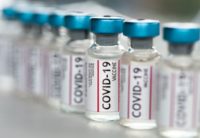In January, global packaging company Amcor was hearing reports of a coronavirus spreading in China, where it has six manufacturing sites. In February, Amcor activated its Global Crisis Response team. Amcor’s VP EHS, Jim Keith, shares what the packaging leader has learned so far from managing through a global pandemic.
Our business has 250 manufacturing operations and offices in more than 40 countries, and around 50,000 employees in our care. Every day, those people make vital packaging for food and beverages, pharmaceuticals, medical equipment and other essential products – all of which are in high demand during the pandemic.
Early on, Amcor aligned around three objectives: to protect our people’s health and safety, to maintain our operations, and contribute to local communities. In pursuit of these objectives, we prioritized relationships with employees and their families, customers, suppliers, and community groups. As the pandemic has evolved, some core principles have proven extremely valuable:
- Health and safety are personal: Amcor draws on a culture that has safety, collaboration and integrity among its values. This means our leader are well versed in the mantra that true safety leaders genuinely care about people and that safety is an accountability we all share.
Very few things in the workplace have such personal meaning as health and safety.As Maslow’s Hierarchy of Needs outlines, we all have an innate desire for safety and security, which is pervasive and applies at home and in the workplace. If we feel it is compromised, this causes concern and action soon follows to restore it.
At times of stress, people have a heightened awareness of health and safety.Pandemics cause genuine concerned about being infected and the unprecedented nature of this virus has caused significantly increased levels of anxiety.Tapping into this pervasive human need for safety and security unlocks a powerful connection we all share to protect ourselves and each other.So, not only is safety personal, it’s also a force multiplier.
- Assemble the team early: At the heart of any effective crisis response is a well-prepared and rehearsed core team comprised of key business leaders and critical functional heads. Having the business groups (or divisions) represented, and engaging critical functions, is vital when fast-paced, risk-based decisions are necessary. It’s also important members are willing and able to serve as decision-makers for their respective business or function.
In our case, we have two levels of COVID-19 response teams (CRTs); a global CRT, and business group CRTs.Our global CRT has representatives from Amcor’s six business groups, corporate offices, and enabling functions including procurement, commercial and legal.Members of our Global Management Team also participate, including our CEO.
The business group CRTs represent and support their respective businesses, with participation from HR, EHS, operations, legal, and others.The business Group presidents also participate.Where group footprints overlap in a country, the CRTs form clusters to maintain consistency.
Response team compositions will differ, company to company.Any team should align with the organization’s structure and needs and have the right decision makers onboard.
- Set clear objectives: Establishing direction and targets for the overall effort is important. Clear objectives guide scope, risk tolerance, and decision-making. They serve as a measure of success and help people focus on purpose and desired outcomes and avoid “out of scope” issues.
Amcor’s core objectives – protecting people, maintaining delivery, and contributing to local communities – have helped us drive purposeful actions and outcomes. The first two objectives were quite simple to establish, as they are Company imperatives. For the third, it quickly became evident that our scale offered an opportunity to support local communities with products or services and donations to charitable groups.
We have created traction on all three objectives and continue to demonstrate our commitment to communities around the world.
- Balance policy with agility: Pandemics, particularly this one, are dynamic and somewhat unpredictable, especially early on. In any large-scale response, it’s vital to have clear policies, protocols and operating mechanisms to help the organization navigate these uncharted waters. While these provide policy guideposts, a plethora of additional issues arise that broad policy won’t address. These issues often include personal factors, medical advice and protocols, supply chain challenges, customer needs, interpretation of government mandates, and so forth.
This pandemic has presented some unique challenges.Community lockdowns and shelter-in-place rules are creating challenges for employee families, including childcare coverage, home-schooling, and travel restrictions and curfews.Most of these challenges are relatively new and require a thoughtful and compassionate response.
We are balancing broad policy positions with being agile enough to quickly and responsibly resolve new issues.Daily response and decision-making are rooted in Company policy while allowing for CRT discretion on situation-specific challenges.
- Communicate and share exhaustively: Pandemics inherently involve unknowns, especially in the early stages. Questions often exist about infection spread, mortality rate, symptoms, where hot spots are expected, and so on. Media coverage is hyperbolic and unavoidable (let’s be honest, fear sells). Even when facts and data may conflict with other narratives, fear usually persists. It is necessary to put significant effort into reliable employee communications to directly address concerns.
In the current COVID-19 pandemic, fear is more evident, widespread and prolonged than any other event I’ve witnessed in my career.As was the case with previous pandemics, managing perception of risk takes as much effort as managing real risk. This pandemic certainly underscores that statement.
As the global response to COVID-19 continues, we are being careful not to underestimate the challenges ahead. In doing so, we maintain unwavering focus on the health and safety of our people. That, in turn, means a protected workforce is one also capable of continuing to deliver packaging to protect millions of critical consumer goods, every day. We are deeply proud of the commitment of our people to our vital role in delivering essential food and healthcare products worldwide, and we will continue to take all necessary precautions to protect them.



